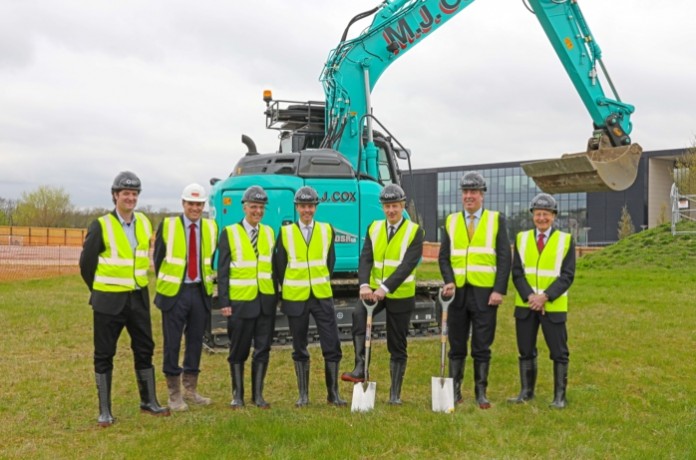
The minister of state for universities, science, research and innovation, Jo Johnson MP, visited The Oxford Science Park (“the Park”) yesterday (Tuesday 4 April) to take part in an official ground-breaking ceremony and reveal the name of the £13 million state of the art new office and laboratory building capable of accommodating 500 people.
The Schrödinger Building will be named after Austrian theoretical physicist professor Erwin Rudolf Josef Alexander Schrödinger (1887 – 1961). Awarded the Nobel Prize for Physics in 1933, he was one of the great scientists of the twentieth century. Schrödinger came to Magdalen College Oxford, which owns The Oxford Science Park, to a Fellowship from 1933 to 1938.
Rory Maw, bursar, Magdalen College, Oxford said: “Few people can claim to have had such an impact in the field of quantum theory as Erwin Schrödinger. Today his memory will live on in the Park’s state of the art new office and laboratory building: The Schrödinger Building. We were honoured that Jo Johnson visited us today to be part of this literally ground breaking day. We continue to develop the Park as a long-term strategic asset which supports growth, discovery, innovation and entrepreneurship.”
The Minister was introduced to three business leaders from the Park: Constantin Coussios, founder of OxSonics and OrganOx and a fellow of Magdalen College; Lee Bryant, managing director, Sesui, the cloud-based telephony and contact centre innovator based in The Magdalen Centre; and Dr Tom Payne, chief technology officer, Oxford Genetics, a leading biotech specialising in DNA design, protein expression optimisation and cell line development technologies and services.
Universities and science minister Jo Johnson said: “Oxford’s world-leading success is built on its research excellence that continues to attract the best minds and cement the UK’s reputation as an innovative nation.
“The new Schrödinger Building will be another important addition to Oxford, supporting the relationship between academics and businesses to foster the development of pioneering start-ups. Our Industrial Strategy will build on these existing strengths to ensure the UK remains at the forefront of global science.”
The Minister also met with Councillor Bob Price, leader of Oxford city council and a board member of Oxfordshire LEP.
Bob Price said: “Oxford’s science and technology base is booming and demand for space is massively outstripping supply. The recent announcement by Novo Nordisk that they will be locating key researchers to the Old Road Campus is an indication of Oxford’s reputation in medicine and biosciences. The Schrödinger Building is a much-needed addition to the supply of state of the art office and laboratory accommodation in the City.
“We recently announced plans with Magdalen College and Thames Water, for a mixed-use community south of Grenoble Road which will include a logical and integrated expansion of the Science Park. It remains important that these plans are unlocked to capture the known demand for housing and commercial workspace in the City.”
Piers Scrimshaw-Wright, managing director, The Oxford Science Park said: “We were delighted to have the Minister with us to mark the occasion of breaking ground for The Schrödinger Building. The Oxford Science Park is synonymous with innovation and entrepreneurship. This has come about by fostering a rich and diverse commercial eco-system where academics, researchers and those in commerce can collaborate. Maintaining this collegiate ethos remains an essential ingredient of The Oxford Science Park’s success.”
The Minister also met with the president of Magdalen College Sir David Clary and members from the Park’s project team: Byron Byrne, director, The Oxford Science Park and professor of engineering science at the University of Oxford; Ian Bogle, managing director, Bogle Architects; Simon Carey, managing director, Barnwood Construction; and Scott Harkness, head of commercial division, Carter Jonas.




















